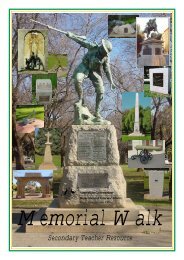The battle for Greece & Crete.pdf - Army Museum of South Australia
The battle for Greece & Crete.pdf - Army Museum of South Australia
The battle for Greece & Crete.pdf - Army Museum of South Australia
Create successful ePaper yourself
Turn your PDF publications into a flip-book with our unique Google optimized e-Paper software.
What was originally planned<strong>The</strong> British War Cabinet and the Greek Government agreed that an ‘Expeditionary Force’ to be knownas ‘Lustre Force’ would be provided and would consist <strong>of</strong>:Three Infantry Divisions, one Armoured Division (maybe a second), a Polish Brigadea total <strong>of</strong> about 100,000 troops.<strong>The</strong> troops were to be supported by – 240 Field Guns – 32 Medium Guns –192 AA (anti-aircraft) Guns- 202 Anti- Tank Guns- 142 Tanks- 5 RAF Squadrons<strong>The</strong>se troops were to consist <strong>of</strong>:1 st <strong>Australia</strong>n Corps HQ – 6 th & 7 th <strong>Australia</strong>n Divisions – 2 nd New Zealand DivisionaBritish Armoured Brigade- a Polish Brigade.<strong>The</strong> <strong>for</strong>ce was to be under the command <strong>of</strong> General Sir (Jumbo) Maitland Wilson, who was GeneralWavell’s trusted ‘Right Hand Man.Wilson was known <strong>for</strong> his dislike <strong>of</strong> the <strong>Australia</strong>ns and they in turn were not impressed with him.General Blamey thought that he lacked ‘enough grey matter – unintelligent’ and Robert Menzies the<strong>Australia</strong>n Prime Minister described him as ‘tall, fat and cunning’.What was providedInitially on the 1 st November 1940 a British Battalion landed on <strong>Crete</strong>, this was followed on the 3 rdNovember by eight fighter bombers at Eleusis near Athens. By the 15 th November some 4,247 troopswere to be stationed in <strong>Greece</strong>, these numbers included three Air Squadrons. Some <strong>of</strong> these unitswere medical units – 26 th British General Hospital- 189 th Field Ambulance- 48 th Field Hygiene-168 th British Light Field Ambulance – 4 th British Light Field Ambulance.By the 11 th February 1941 “Lustre Force” consisted <strong>of</strong>1 st <strong>Australia</strong>n Corps HQ- 6 th <strong>Australia</strong>n Division – 2 nd New Zealand DivisionaBritish Armoured Brigade and A number <strong>of</strong> British Medical Units..<strong>The</strong> Polish Brigade remained in Egypt and the 7 th <strong>Australia</strong>n Division in Africa as a result <strong>of</strong> Rommel’sinvasion <strong>of</strong> Cyrenaica. No one seems to know what happened to the five RAF Squadrons.<strong>The</strong> <strong>Australia</strong>n ViewGeneral Wavell in<strong>for</strong>med General Blamey <strong>of</strong> the raising <strong>of</strong> ‘Lustre Force’ on the 18 February 1941, the<strong>Australia</strong>n Government agreed to the concept on 26 February 1941. <strong>The</strong> first allied troops reached<strong>Greece</strong> on the 7 th March.Blamey argued with Wavell that as the ‘Force’ consisted mainly <strong>of</strong> Dominion Troops (<strong>Australia</strong> andNew Zealand) the <strong>for</strong>ce should be commanded by a Dominion Officer. Wavell commented that only42,000 troops would be <strong>Australia</strong>n and New Zealand. When ‘Lustre Force’ was actually raised andsent to <strong>Greece</strong> it consisted <strong>of</strong>:17,125 <strong>Australia</strong>ns and 16,700 New Zealanders, and they in fact made up theactual combat Infantry in ‘Lustre Force’yet he still persisted in appointing a British Officer to command the Force.- 2 -











